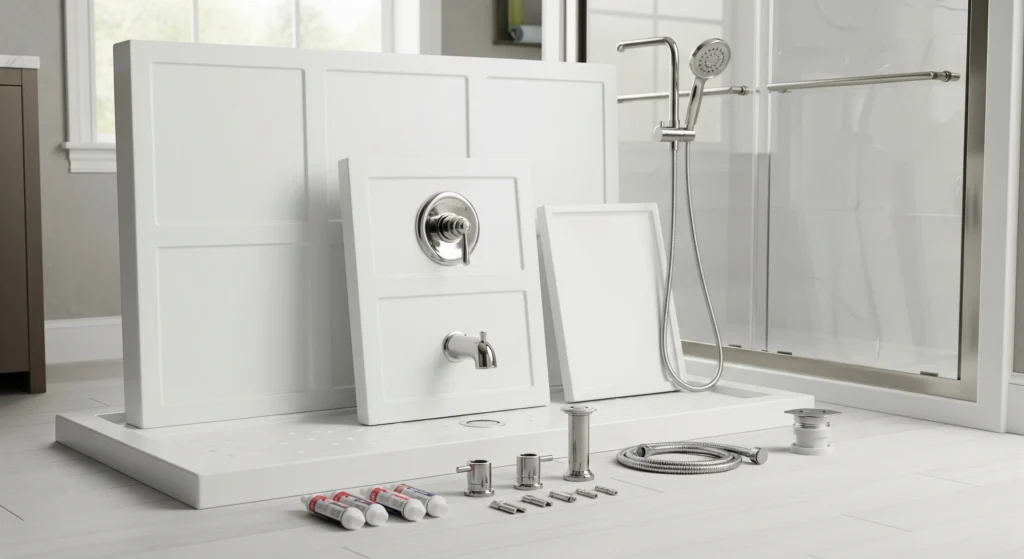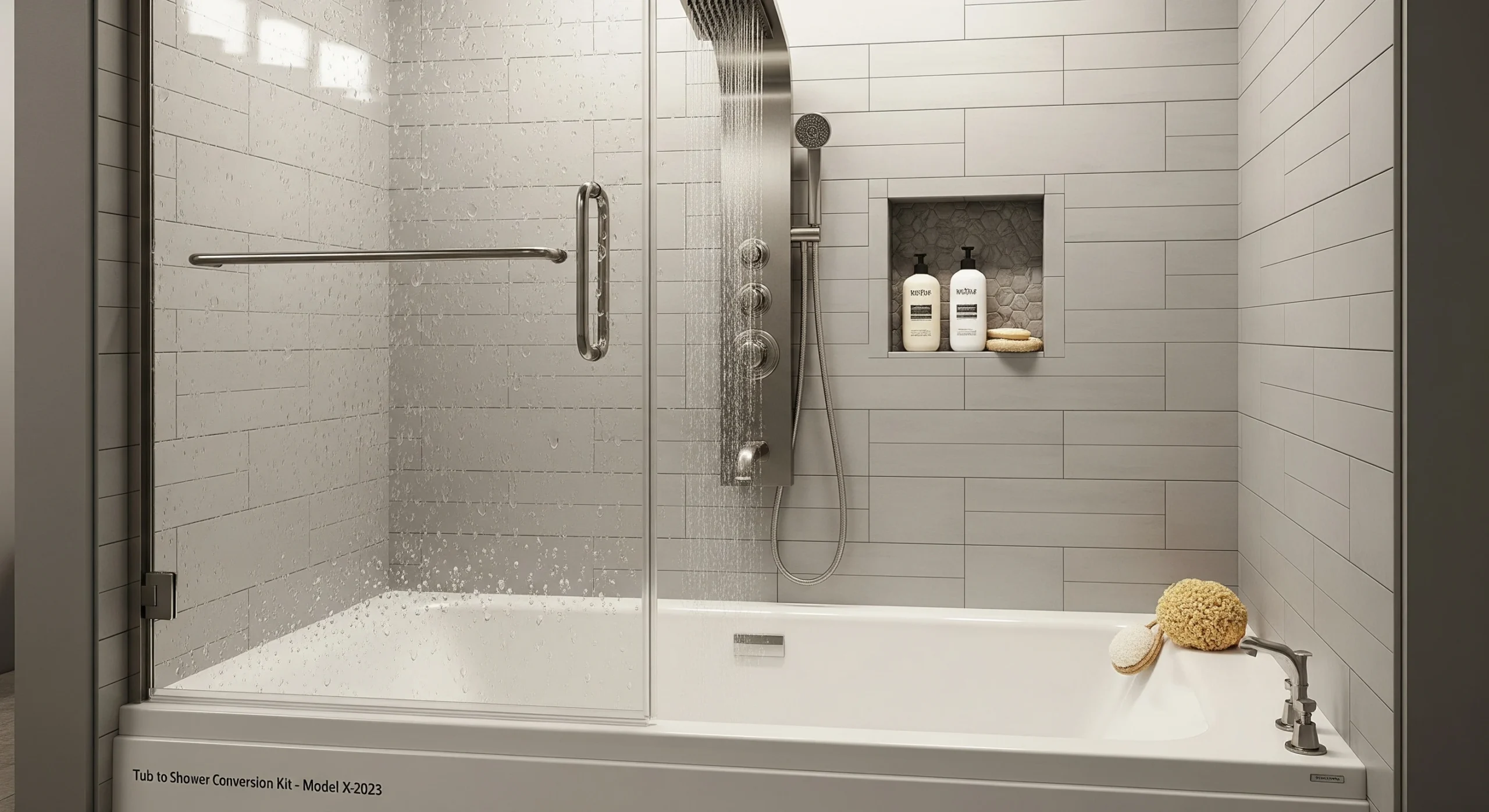Converting a bathtub to a shower is definitely possible—and it’s a popular bathtub remodeling project for homeowners looking to modernize their bathrooms or improve accessibility.
Overview
Bathtub Remodeling
It is well known as a tub to shower conversion. It is a popular bathroom remodeling project for homeowners seeking a more modern, accessible, and space-efficient bathroom design. This renovation transforms an existing bathtub area into a walk-in or stand-up shower, often improving both functionality and the resale value of your home.

A tub-to-shower conversion is considered a moderately difficult project, especially for beginners without much DIY or plumbing experience. It’s often best to hire professionals with basic carpentry and plumbing skills for this type of work. However, the process can be relatively straightforward if you use a prefabricated shower conversion kit and keep the existing plumbing layout.
Tub to Shower Conversion
Basically Tub to shower conversion involves the following steps, Here i listed those for your referance:
- Demolition: Removing the existing bathtub and surrounding tile or enclosure.
- Plumbing Adjustments: Reconfiguring the plumbing to accommodate a shower drain and fixtures.
- Shower Base Installation: Installing a shower pan or a custom-tiled base.
- Wall Surrounds: Adding waterproof wall panels or tiling the shower walls.
- Shower Fixtures: Installing a showerhead, controls, and possibly a handheld sprayer.
- Glass Doors or Curtains: Choosing between a sleek glass enclosure or a curtain rod.
Benefits
- Accessibility: Easier entry, especially with low-threshold or curbless designs.
- Space Efficiency: Showers often make a bathroom feel more open.
- Modern Aesthetic: A clean, updated look.
- Customization: Options for built-in benches, niches, rain showerheads, etc.
Considerations
Resale Value: In homes with only one bathroom, it’s often wise to retain at least one bathtub to maintain resale appeal, particularly for families with young children.
Budget: The cost of a tub-to-shower conversion typically ranges from $1,800 to $8,000, depending on the project’s size, materials, and labor. The national average is around $3,100.
Permits: May be required depending on your location and plumbing changes.
Waterproofing: Critical to prevent leaks and mold.
Plumbing: Relocating drain or supply lines increases both cost and complexity. Many homeowners minimize expenses by keeping the new shower in the tub’s original location.
Disposal: Removing a bathtub can create bulky, heavy debris. If you’re handling the demolition yourself, consider renting a dumpster for safe and easy disposal.
Key Steps in Tub-to-Shower Conversion
1. Assess your space and plumbing.
Start by checking your bathroom’s layout and existing plumbing. You’ll usually want to use your current bathtub’s footprint (typically 60″ x 30″) to reduce plumbing changes and overall costs.
2. Choose your design.
Decide what type of shower you want. You can choose a prefabricated shower kit, a custom tile enclosure, a barrier-free or curbless design, or a model with built-in seats and grab bars for better accessibility.
3. Prepare for demolition.
Remove the old bathtub, fixtures, and any surrounding tile or drywall that needs to be replaced. Make sure to turn off the water supply before starting.
4. Install the new shower base.
Set the new shower base or pan in place and update the plumbing as needed. Once that’s done, install your new wall materials, such as acrylic panels or tile.
5. Finish and seal.
Add the doors, curtains, or glass enclosure, then install the fixtures. Seal all waterproof areas carefully and check that the drainage works properly before using your new shower.
Choosing the Right Bathtub-to-Shower Conversion Kit
Here’s a detailed breakdown of the top bathtub-to-shower conversion kits available in 2025, including features, pros, and ideal use cases:
1. DreamLine Shower Base + QWall-5 Backwall Kit
- Best For: Overall performance and customization
- Features:
- Acrylic shower base with slip-resistant surface
- QWall-5 backwall panels with tile pattern
- Compatible with DreamLine glass doors
- Multiple size options
- Pros:
- High-quality materials
- Sleek, modern look
- Easy to clean
- Ideal For: Homeowners seeking a premium, stylish upgrade
2. Delta Classic 500 Shower Wall + Pan Kit
- Best For: Budget-friendly remodels
- Features:
- Durable acrylic panels with built-in shelves
- Textured shower base for safety
- Snap-together installation
- Pros:
- Affordable
- DIY-friendly
- Trusted brand
- Ideal For: Cost-conscious users or first-time remodelers
3. Craft + Main Jetcoat 5-Piece Kit
- Best For: Fast installation
- Features:
- Waterproof wall panels with stone or tile look
- No grout required
- Interlocking design
- Pros:
- Quick setup (often in one day)
- Stylish finishes
- Low maintenance
- Ideal For: Quick renovations or rental properties
4. Step-Through Tub Conversion Kit
- Ideal For: Aging-in-place upgrades or limited budgets
- Best For: Accessibility and safety
- Features:
- Cut-out insert for walk-in access
- Works with existing tub
- Optional safety rails
- Pros:
- No need to remove the tub
- Great for seniors or mobility concerns
- Affordable alternative to full remodel
When Is It Easy?
Converting a tub to a shower is usually easiest when you use a conversion kit and keep the new shower in the same location as the old bathtub.
Bathrooms on the second floor or those built on pier-and-beam foundations tend to be simpler to work with, since modifying drain lines and making carpentry adjustments is less complicated.
Homeowners with basic DIY skills can often manage straightforward conversions themselves, especially when no major plumbing changes are needed.
When Is It Difficult?
The project becomes more complex if you need to relocate drain lines, upgrade plumbing, or repair damaged framing or subfloors.
Tasks like installing custom tile, creating a curbless shower, or ensuring proper waterproofing require professional expertise and more time.
Ground-floor bathrooms with slab foundations are particularly challenging, as plumbing changes are more labor-intensive and may require professional assistance.
Inexperienced DIYers also risk costly errors or leaks if waterproofing and plumbing connections aren’t done correctly.
FAQ: How to Convert Your Bathtub to a Shower
1. Why should I consider converting my bathtub to a shower?
Converting a tub to a shower can improve accessibility, especially for seniors or those with mobility issues. It also modernizes your bathroom, saves space, and can increase your home’s resale value—particularly if you already have another bathtub in the house.
2. Can I do a tub-to-shower conversion myself, or do I need a professional?
It depends on your skill level and the complexity of the project. Many conversion kits are designed for DIY installation and come with detailed instructions. However, if plumbing needs to be relocated or if you’re unfamiliar with waterproofing and tiling, hiring a professional is recommended to avoid costly mistakes.
3. What is a bathtub-to-shower conversion kit?
A conversion kit typically includes a shower base (or pan), wall panels, and sometimes doors or curtains. These kits are designed to fit into the space left by a standard bathtub, making the transition to a shower easier and more cost-effective.
4. How much space do I need for a shower conversion?
Most standard bathtubs are about 60 inches long and 30–32 inches wide. Most conversion kits are designed to fit this footprint. However, always measure your existing space carefully and choose a kit that matches your dimensions and drain location.
5. What types of conversion kits are available?
There are several types:
- Standard Kits: Include a shower base and wall panels.
- Accessible Kits: Feature low-threshold or curbless entries for wheelchair access.
- Step-Through Inserts: Modify your existing tub for easier entry without full removal.
- Customizable Kits: Allow you to choose finishes, shelving, and door styles.
6. How long does a tub-to-shower conversion take?
A basic conversion using a pre-fabricated kit can take as little as 1–2 days. More complex projects involving custom tile work, plumbing changes, or structural modifications may take up to a week or more.
7. How much does it cost to convert a bathtub to a shower?
Costs vary widely:
- DIY Kits: $600–$2,000 depending on quality and features.
- Professional Installation: $2,500–$8,000 or more, depending on labor, materials, and complexity. Accessible or luxury upgrades (like frameless glass doors or rainfall showerheads) can increase the price.
8. Do I need a permit to convert my tub to a shower?
In many areas, yes—especially if plumbing is being altered. Always check with your local building department before starting the project. A licensed contractor can help secure the necessary permits.
9. What should I look for in a good conversion kit?
Key features to consider:
- Durability: Acrylic or composite materials resist cracking and are easy to clean.
- Waterproofing: Ensure the kit includes or supports proper waterproofing.
- Style: Choose wall panels and doors that match your bathroom aesthetic.
- Drain Compatibility: Make sure the shower base aligns with your existing plumbing.
- Ease of Installation: Look for interlocking panels or pre-leveled bases for simpler setup.
10. Will removing my bathtub hurt my home’s resale value?
It depends. If your home has only one bathroom, removing the only tub could deter some buyers—especially families with young children. However, if you have another bathtub elsewhere, a modern shower can actually boost appeal and value.
11. Can I add features like benches or niches?
Yes! Many kits offer optional accessories like built-in benches, corner shelves, or recessed niches for storage. These can enhance both functionality and comfort.
12. Are there eco-friendly options?
Absolutely. Look for kits made from recycled materials or low-VOC components. Water-saving showerheads and efficient plumbing fixtures can also reduce your environmental impact.





Leave a Reply